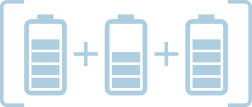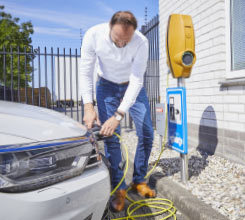The world of the
REMONDIS Lippe Plant
The saying “to kill two birds with one stone” was thought up for situations just like this: by using old car batteries in the battery storage unit at the Lippe Plant, we are not only making the very most of their potential – we are also helping to support the country’s switch from fossil fuels to renewable energy. The perfect way to balance out sudden dips in the national grid.
Conserving natural resources
First reused, then recycled – what happens to the batteries at the Lippe Plant.

Helping the energy switch
Why renewable energy needs the support of battery parks.

Sustainable e-mobility

Project partners
The battery park at the Lippe Plant is one of the world’s largest second-use storage units for car batteries. And it is also the smartest solution for used battery systems from electric cars. A total of 1,000 batteries – all from smart fortwo electric drive models – have been incorporated into a huge storage unit with an overall capacity of 12 megawatts. The battery park is directly connected to the national grid and can store or release energy as it is required. This means that it is perfect for levelling out any dips in energy supply – especially as it is a fully automated system that can respond within a fraction of a second. At any time of the day or night. This not ensures there is a reliable supply of electricity, it also offers financial advantages as using such battery storage units minimises the costs of extending the grid.

Packed tightly together to store 12 megawatts: 1,000 old batteries from electric driven cars

The plant’s fire brigade would be notified immediately in the case of a fire
As units like as this involve such large amounts of energy, safety is, of course, a very important factor. The battery park is setting new standards here as well and absolutely nothing has been left to chance. The fire alarm system guarantees that any smoke or heat generation is detected immediately and switches the whole system – fully automatically – into safety mode. In fact, the whole of the unit is completely digitalised. Employees can permanently observe and monitor all operating parameters live.
Just because a battery can no longer be used in an electric driven car, it does not mean that it is no longer of use. On the contrary: they can continue to store valuable energy for up to ten years when installed in such second-use battery storage units. Each individual battery is an excellent example of efficiency and helps to conserve our planet’s natural resources. This impact is further increased if the battery ends up in the second-use battery storage unit at the Lippe Plant. Why? Because anything that finds its way into Europe’s largest industrial recycling centre gets the people there thinking about what should happen to it after it reaches the end of its useful life. Across the world, researchers are looking at ways to recover as many raw materials as possible from the batteries – the ultimate aim being, of course, to recover them all. This includes components such as copper, aluminium, graphite and plastics as well as – in particular – the rare metals, lithium and cobalt.
Using batteries in the second-use battery storage unit doubles their useful life

At peak periods, wind farms produce more energy than the grid can absorb. Temporary storage solutions need to be found such as the one at the Lippe Plant
Even if our politicians can’t agree on the speed or the exact schedule of the switch to renewable energy, there is no doubt that it will happen. Will? It is already well underway. Both wind and solar energy are becoming increasingly important in Germany. 80% of the country’s electricity should come from renewable sources by 2030. However, as we gradually turn our backs on fossil fuels, we find ourselves having to deal with an additional problem: while wind and solar power are greener than coal, gas and oil, they are less reliable, producing neither a constant nor uniform amount of energy. The result is fluctuations in the grid and concerns about energy supply. This is the main problem of renewable energy and the sooner a solution is found for this, the better. Projects such as the second-use battery storage unit at the Lippe Plant can help level out such fluctuations – making them both an important cornerstone and pioneer of the energy transition.
E-mobility will soon begin to pick up pace when the upcoming law banning manufacturers from building new cars with internal combustion engines comes into force. This will also mean new challenges for the recycling industry. Old batteries from EVs may be a recycling niche product at the moment but there will be millions of them in the not too distant future. All the more reason, therefore, to develop new solutions for reusing and recycling such products. A task that can best be solved as a collaboration – as is the case with all big challenges by the way – between producers and recyclers. This is the only way to find the most sustainable solution.

More e-mobility means fewer emissions – and new recycling challenges
Conditions are changing so quickly today and, of course, they create new challenges for the recycling sector. Old batteries from electric cars may be a recycling niche product at the moment but there will be millions of them in the not too distant future. All the more reason, therefore, to develop new solutions for reusing and recycling such products. A task that can best be solved as a collaboration – as is the case with all big challenges by the way – between producers and recyclers. This is the only way to find the most sustainable solution.
The best results are always achieved when experts from all relevant areas put their heads together to come up with a solution. The REMONDIS Group’s synergies demonstrate this every single day. The battery park is an example of how we have extended this successful in-house formula to include external players. By doing so, all aspects of an electric car battery’s life cycle have been covered. The battery systems are manufactured and processed by ACCUmotive, a subsidiary of Daimler AG, which sells electric and plug-in hybrid vehicles. The Mobility House and GETEC are responsible for the installation and marketing of the stationary battery unit to the energy markets. In the future, REMONDIS will be in charge of recycling the batteries once they reach the end of their useful life and recovering the raw materials so they can be returned to production cycles.


Diese Seite verwendet aktuelle Techniken, die in dem von Ihnen verwendeten Browser unter Umständen nicht korrekt
angezeigt werden können.
Bitte aktualisieren Sie Ihren Internet-Explorer oder weichen auf einen anderen Browser wie Chrome oder
Firefox aus.
Schließen